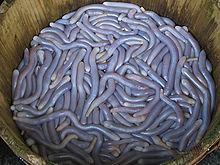Sipuncula
| Sipuncula Temporal range: Cambrian–Recent |
|
|---|---|
 |
|
| Scientific classification | |
| Kingdom: | Animalia |
| Superphylum: | Lophotrochozoa |
| Phylum: |
Sipuncula Rafinesque, 1814 |
| Classes, orders and families | |
|
|
The Sipuncula or Sipunculida (common names sipunculid worms or peanut worms) is a group containing 144–320 species (estimates vary) of bilaterally symmetrical, unsegmented marine worms. Sipuncula signifies "little tube or siphon." Traditionally considered a phylum, they might be a subgroup of phylum Annelida based on recent molecular work.
The first species of this phylum was described in 1827 by the French zoologist Henri Marie Ducrotay de Blainville who named it Sipunculus vulgaris. A related species was later described as Golfingia macintoshii by E. Ray Lankester. The specimen was provided by a friend of his, Professor Mackintosh. The specimen was dissected by Lankester between rounds of golf at Saint Andrews golf club in Scotland from which the species derives its name. Golfingia is now the genus name and Sipuncula the name of the phylum to which these worms belong.
Sipunculids are all marine. They are relatively common in shallow waters, either in burrows or in discarded shells as hermit crabs do. Some bore into solid rocks to make a shelter for themselves. Although typically less than 10 cm long, some sipunculans may reach several times that length
Sipunculans are worm-like animals ranging from 2 to 720 millimetres (0.079 to 28.346 in) in length, with most species being under 10 centimetres (3.9 in). The sipunculan body is divided into an unsegmented trunk and a narrower, retractable anterior section, called the "introvert". Sipunculans have a body wall somewhat similar to that of annelids (though unsegmented) in that it consists of a non-ciliated epidermis overlain by a cuticle, an outer layer of circular and an inner layer of longitudinal musculature. The body wall surrounds the coelom that is filled with fluid on which the body wall musculature acts as a hydrostatic skeleton to extend or contract the animal. When threatened, Sipunculids can retract their body into a shape resembling a peanut kernel—a practice that has given rise to the name "peanut worm". The introvert is retractable into the trunk via two pairs of retractor muscles that extend as narrow ribbons from the trunk wall to attachment points in the introvert. The introvert can be protruded from the trunk by contracting the muscles of the trunk wall, thus forcing the fluid in the body cavity forwards.
...
Wikipedia
